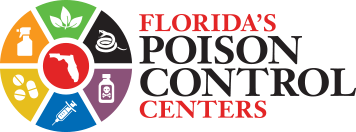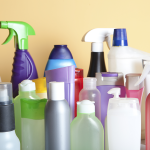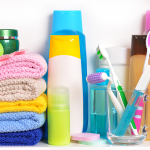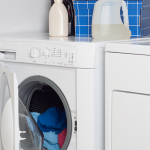Household Products
Poison control centers receive many calls every day about people poisoned by a cleaner or household product. Most commonly, people get a taste of something toxic, but chemicals can also be inhaled or even splashed into the eyes or on the skin. Sometimes these calls are about a small child who has tasted a colorful product thinking it was juice, or eaten a pill thinking it was candy. We have many “look-alike” products in our homes. Products can have a similar color and shape to a known object, or dangerous products may have pictures of food on the label. “Look-alikes” are not only a problem for children: even adults who are distracted or who have low vision can easily make these mistakes. The good news is that most of these poisonings are easily managed at home. Very few of these poisonings require urgent medical care. The sections below describe hazards that may exist in different parts of your home and some facts about poisonings at home. For more information contact Consumer Product Safety Commission, SaferProducts.gov, Safe Kids Worldwide or American Cleaning Institute.
Locations of Possibly Dangerous Products
Safety Tips
- Do not mix different household cleaners. Mixing bleach with ammonia or other cleaners can produce a toxic gas.
- Make sure all products are stored up high in secured or locked cabinets. A variety of safety devices are available for different types of cabinets. Child resistant caps also help keep children from accidentally opening containers.
- All products should be kept in their original containers and away from foods.
- Alcoholic beverages can be harmful if ingested by small children and should be kept in a secure place.
- Medicines should not be left on tables within sight.
- Oven cleaner, drain cleaner and furniture polish are particularly dangerous. Find a cabinet located up high or in a utility room with a lockable door to store these dangerous products.
- Don’t keep them under the kitchen sink; this is well within a young child’s reach.
Hazardous Products Found in the Kitchen
- Cigarettes, e-cigarettes and nicotine products
- Metal cleaner
- Ammonia
- Oven cleaner
- Rust remover
- Carpet and upholstery cleaners
- Medicines/vitamins
- Alcoholic beverages
- Drain cleaners/lye
- Furniture polish
- Dishwasher detergent
- Cleanser and scouring powders
Facts About Household Cleaning Products
- All-purpose cleaning agents are a large cause of poisonings because they are easy to get into under the kitchen sink.
- Youngsters often confuse cleaners and food items because packaging is similar.
- Safety latches will not keep children out of cabinets and drawers, but they will slow children down.
- Soaps and detergents can cause choking and vomiting. Some are more serious than others.
- Toilet bowl cleaners (even the drop-in tablets) can cause burns in the mouth, esophagus and stomach.
- Most unintentional poisonings happen when a cleaning product is being used. Keep the product out of reach of children. Never leave a child in a room with an open container, even for “a few seconds.”
Safety Tips
- Do not mix different household cleaners. Mixing bleach with ammonia or acid can produce a toxic gas.
- All medicines should have child-resistant caps and be locked away from children.
- Even though a product has a child safety cap, remember: It is only child-resistant, not childproof! Children can and do manage to open these caps.
- Don’t let children play with full containers; the child may end up consuming the contents.
- Items in a medicine cabinet can be accessible to children.
- An alternative to using the medicine cabinet is to invest in a locked tackle box.
- Keep all medicines in the original containers with original labels.
- Safely dispose of all out of date or unneeded medications by spoiling them and putting them out on trash day or by taking them to a community drug take-back event.
- Shampoos, perm solutions, deodorants, mouthwash, after-shave and sprays are poisonous if used improperly.
Hazardous Products Found in the Bathroom
- Medicines
- Shampoo, wave lotion and sprays
- Lotion/cream
- Nail polish and remover
- Suntan lotion
- Deodorants
- Shaving lotion
- Toilet bowl cleaner
- Pine oil and bath oil
- Rubbing alcohol
- Room deodorizer
- Tub/tile cleaners
Safety Tips
- All laundry room products should be tightly closed (since most do not have child-resistant caps) and stored on high shelves or in locked cabinets.
- Detergents, bleaches, fabric softeners, bluing or dyes can be harmful if swallowed.
- Powder cleaners can be harmful if inhaled.
Hazardous Products Found in the Laundry Room
- Laundry detergent; unit-dose pods are especially harmful if splashed in the eye or swallowed by toddlers
- Stain remover
- Bleach
- Fabric softener
- Dye
Facts About Laundry Room Hazards
- When swallowed, regular bleach may cause choking but it is not a deadly poison. It is more harmful if it gets on the skin or splashed in the eyes.
- Children often mistake laundry granules for sugar.
Garage/Storage Areas
Hazardous Products Found in the Garage/Storage Areas
- Kerosene/gasoline
- Pesticides
- Lighter fluid
- Turpentine/paint thinner
- Paint and paint remover
- Weed killers
- Fertilizers/lime
- All automotive products
- Rat and ant poisons
- Mothballs and cakes
Facts About Garage/Storage Hazards
- Many poisonings happen because poisonous products were stored in a milk or drink container instead of their original packaging.
- Antifreeze is a deadly poison for people and pets.
- Mothballs have NOT been scientifically proven to keep away snakes or rodents. One mothball containing naphthalene can be a dangerous poison in a small child or pet.
Safety Tips
- Dangers in the bedroom include medicines, such as sleeping pills, left on night stands or in unlocked suitcases. This is especially common when visitors are staying at your home.
- Parents should provide their guest with a safe place to store their medicines.
- Medicated ointments can be toxic if swallowed.
- Keep all of these products out of children’s reach by locking them away.
- Baby products such as powder, oils and teething gels can be toxic if not used as directed on the label.
Hazardous Products Found in the Bedroom
- Medicines/vitamins
- Medicated ointments
- Perfume
- Potpourri and scented oils
- Baby changing table product
New Poisons on the Market
New household products are released onto the market all the time and some of them prove to be attractive and dangerous to children. Poison control centers share their data with the press and with government agencies to identify products that have caused harm. Your calls to poison control centers help keep the public safe. For more information about the latest products of concern, visit the American Association of Poison Control Centers or connect with them on Facebook.
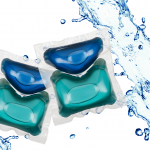 Single-dose Laundry and Dishwasher Packets
Single-dose Laundry and Dishwasher Packets
A new type of laundry and dishwasher detergent now on the market is packaged in “single dose packets” that dissolve in the washing cycle. The packets are colorful, squishy and are attractive to children. Callers have reported these products have been mistaken for candies, gummies, or marshmallows. Poison control centers around the country have logged many calls about people exposed to this type of detergent product. Types of products cited include Tide Pods®, Purex Ultra Packs®, Cascade Action Pacs® and Mighty Packs Liquid Laundry Unit Dose®.
Most laundry and dishwasher detergents cause only mild stomach upset or no symptoms at all if ingested, but many poison control centers are seeing unusual symptoms after exposure to these unit dose packs, including
- Prolonged vomiting
- Coughing
- Drowsiness
- Wheezing, choking and breathing problems resulting in hospitalization
- Serious eye damage after product squirted into the eyes.
At present, the cause of the severe symptoms is unknown. It could be due to a higher alkalinity (more corrosive), a product contaminant, or ingredients in the vinyl packet. Product manufacturers have been alerted to the problem and several manufacturers have made changes to their packaging to make these products harder to get into.
Parents and caregivers must keep these products away from children. Children should never be given the products to handle or pop. Call the Poison Help line at 1-800-222-1222 so that medical professionals can assess your individual situation. Exposures to these products may require close observation and possibly hospitalization.
For more information about how to do laundry safely, visit the American Cleaning Institute.

